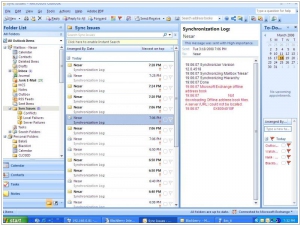Microsoft Exchange vs hMailServer
March 10, 2025 | Author: Adam Levine
20★
Microsoft Exchange Server is the server side of a client–server, collaborative application product developed by Microsoft. Exchange's major features consist of electronic mail, calendaring, contacts and tasks; support for mobile and web-based access to information; and support for data storage.
9★
hMailServer is a free, open source, e-mail server for Microsoft Windows. It's used by Internet service providers, companies, governments, schools and enthusiasts in all parts of the world.
See also:
Top 10 Email Servers for business
Top 10 Email Servers for business
Microsoft Exchange and hMailServer are both email servers, which means they spend their time shuffling messages back and forth in a manner not unlike a hyperactive postal worker who’s had too much coffee. They both speak in SMTP, IMAP and POP3, the arcane languages of email delivery and they both pretend to care deeply about stopping spam. Both allow users to send, receive and generally mismanage their emails with reckless abandon, provided, of course, they’ve been set up correctly—an event which is about as likely as finding an honest used car salesman.
Microsoft Exchange, being a product of Microsoft (USA, for those keeping score), first emerged in 1996, back when email was still a thrilling novelty rather than an unavoidable burden. It is the sort of software that corporations adore and IT departments curse, a vast and complex behemoth that integrates seamlessly with Microsoft 365, assuming you’ve sacrificed the appropriate number of goats to the licensing gods. It offers calendars, contacts and enough collaboration features to ensure that no one ever has an excuse to be unavailable again. It also requires a Windows Server, a small army of system administrators and a willingness to accept that, at any given moment, something inexplicable will stop working.
hMailServer, on the other hand, hails from Sweden, which explains its minimalist and efficient nature. It was created in 2002 and is entirely free, much to the horror of companies who believe software should come with a price tag the size of a small country’s GDP. Unlike Exchange, it does not concern itself with things like calendars or deep Microsoft integration—it simply delivers email and goes back to minding its own business. It’s small, lightweight and ideal for small businesses, developers or anyone who thinks setting up an Exchange server sounds about as fun as juggling chainsaws. It also runs on Windows, but without the need for a full-blown server environment, which makes it a delightfully pragmatic choice for those who just want their email to work without consulting a high priest of IT.
See also: Top 10 Email Servers
Microsoft Exchange, being a product of Microsoft (USA, for those keeping score), first emerged in 1996, back when email was still a thrilling novelty rather than an unavoidable burden. It is the sort of software that corporations adore and IT departments curse, a vast and complex behemoth that integrates seamlessly with Microsoft 365, assuming you’ve sacrificed the appropriate number of goats to the licensing gods. It offers calendars, contacts and enough collaboration features to ensure that no one ever has an excuse to be unavailable again. It also requires a Windows Server, a small army of system administrators and a willingness to accept that, at any given moment, something inexplicable will stop working.
hMailServer, on the other hand, hails from Sweden, which explains its minimalist and efficient nature. It was created in 2002 and is entirely free, much to the horror of companies who believe software should come with a price tag the size of a small country’s GDP. Unlike Exchange, it does not concern itself with things like calendars or deep Microsoft integration—it simply delivers email and goes back to minding its own business. It’s small, lightweight and ideal for small businesses, developers or anyone who thinks setting up an Exchange server sounds about as fun as juggling chainsaws. It also runs on Windows, but without the need for a full-blown server environment, which makes it a delightfully pragmatic choice for those who just want their email to work without consulting a high priest of IT.
See also: Top 10 Email Servers





